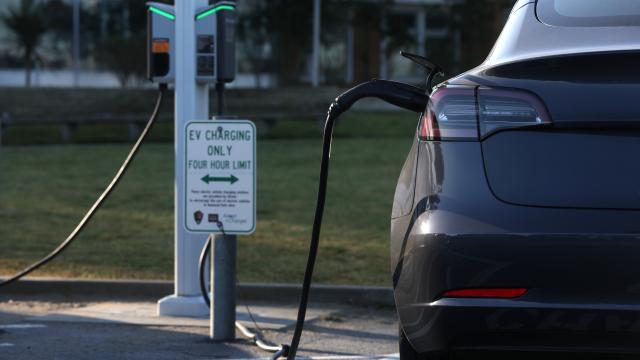On Monday, the Department of Energy announced $US3.1 billion in funding to help boost U.S. production of high-capacity batteries and battery parts, plus another $US60 million in funds to support battery recycling. The U.S. Secretary of Energy, Jennifer Granholm, officially introduced the Biden Administration’s battery plans in a 2pm statement in Detroit, Michigan — where Granholm was governor from 2003 to 2011 — and in a video she tweeted out Monday afternoon.
“Batteries are essential to fuelling the transportation sector with clean energy and providing renewable resources around the clock. Improving battery technology and storage capabilities will help reduce our dependence on foreign oil consumption and lower greenhouse gas emissions,” said Granholm in the video statement.
Though batteries might help up lean less on foreign oil, it’s important to note that the minerals and rare earth metals used in batteries are concentrated in a few places globally. And much of the U.S. sourcing of these materials currently comes from outside of the country. Right now, about 80% of our lithium-ion battery imports come from China, which has mining contracts and operations set up in many of the mineral rich areas of the global south. China is also responsible for processing and refining 80% of the rare-earth metals that the U.S. imports, according to 2020 USGS data.
The new DOE funding comes amid soaring fossil fuel prices prompting renewed calls for the U.S. to boost its domestic energy capacity, and an ongoing federal push for vehicle electrification — starting with the government’s own fleet. The Biden administration previously set a goal for electric vehicles to make up half of all car sales by 2030, via an executive order. To meet that goal alone, we’ll need a much larger battery supply, and thus all of the minerals (like cobalt, nickel, graphite, lithium, and rare earth metals) needed to build those batteries.
There is no doubt that we need to move away from fossil fuels, as quickly as possible to avoid the ever-worsening consequences of climate change. But moving towards all electric cars or more battery storage across the electric grid, though possible, is fraught with potential political, environmental, and human complications.
Money for the new DOE battery investment comes from Biden’s $US1 trillion infrastructure plan, and will be used for “battery research, manufacturing, processing, and [battery] recycling,” according to Granholm. The bulk of the funding is specifically focused on grants to support “the creation of new, retrofitted, and expanded commercial facilities as well as manufacturing demonstrations and battery recycling,” said the DOE in its statement.
Notably, the funding isn’t earmarked for new mining projects, but rather boosting U.S. processing and reclamation of the raw materials needed for battery production. “The Bipartisan Infrastructure Law directs more than $US7 ($10) billion to strengthen the U.S. battery supply chain, which includes producing and recycling critical minerals without new extraction or mining and sourcing materials for domestic manufacturing,” said the statement.
But, more materials will have to be extracted somehow. One 2021 analysis by the International Energy Agency concluded that we’ll need to increase the overall mineral supply six-fold to fulfil growing global battery demand over the next few decades. And for some minerals, that number is way, way higher. The report predicted that demand for graphite will increase 25x over the next 20 years, and that lithium demand will go up by a factor of 70.
Recycling probably can’t solve the all of the scarcity issues, as the U.S. government is well aware. At the end of March, Biden invoked a Cold War-era law to try to boost domestic mineral and metals mining
Though continuing to burn fossil fuels poses a huge threat to just about every species on earth. Moving to expand battery production carries the risk of damaging species and habitats on a smaller scale. For example, lithium mining reduced populations of two flamingo species in Chile’s salt flats, according to one 2022 study published in the journal Proceedings of the Royal Society B. And, in Nevada, a proposed lithium mining site could destroy most of the known range of a rare wildflower called Tiehm’s buckwheat.
And the current mineral mining boom has exacerbated existing global inequities, as in Chile where lithium mines are threatening local peoples’ water supply and Indigenous communities. Or, in the Democratic Republic of the Congo where dangerous cobalt mining operations have killed children working in the mines and led to lawsuits against tech companies including Tesla, Apple, and Google.
With this new funding announcement, though, the DOE is aiming to move towards a better battery supply chain enacting “responsible and sustainable domestic sourcing of the critical materials used to make lithium-ion batteries,” according to the department’s Monday statement. Hopefully, that vision is realised.
